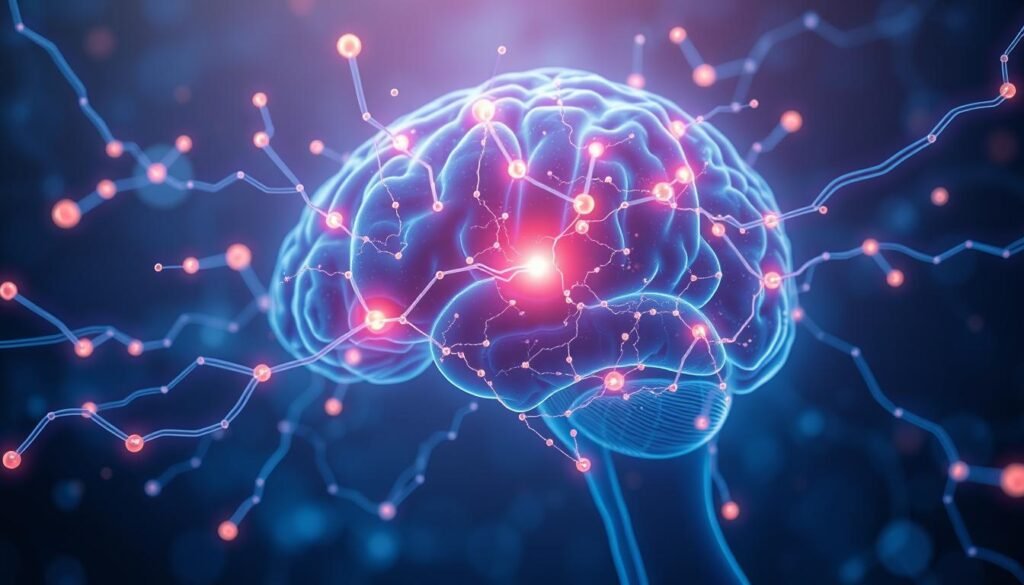About 1 in 10 Americans are prescribed a benzo like Klonopin for anxiety. It helps with excessive worry, muscle tension, and sleep problems. But, its use over a long time raises concerns about dependence and cognitive harm. This article covers Klonopin’s role in treating anxiety, including how it works, side effects, and other options.
Key Takeaways
- Klonopin is widely used for short-term relief of anxiety symptoms.
- Long-term use of Klonopin poses risks including dependence and cognitive issues.
- Non-medication treatment options like Cognitive Behavioral Therapy are effective alternatives.
- Withdrawal symptoms can occur with abrupt discontinuation; gradual tapering is advised.
- Regular doctor visits are essential for monitoring treatment effectiveness and side effects.
What is Klonopin?
Klonopin is widely known by its scientific name, clonazepam. The FDA has approved it for treating several disorders. It mainly tackles seizure disorders, panic issues, and some types of anxiety, like social anxiety disorder.
This medication is a long-acting benzodiazepine and is seen as a Schedule IV controlled substance. Why? Because there’s a risk of misuse and addiction. So, doctors must prescribe and monitor it carefully to make sure it’s used safely.
Klonopin helps by boosting a neurotransmitter that calms the brain, easing the symptoms of these conditions. Adults can take up to 20 mg daily for seizures and 4 mg daily for panic disorders. Kids aged 11 to 17 have the same dosage guidelines as adults. But for little ones under 30 kilograms, the dose starts lower, from 0.01 to 0.03 mg/kg of body weight every day.
There are three strengths of Klonopin tablets—0.5 mg, 1.0 mg, and 2.0 mg. This range helps cater to individual dosage needs. Plus, the generic form of clonazepam is both effective and can save you money compared to the brand name.
However, Klonopin isn’t right for everyone. People allergic to clonazepam, other benzodiazepines, or any of its ingredients should steer clear. It’s also not recommended for those with severe liver issues or a certain type of glaucoma. And the elderly? They should use it cautiously because of potential side effects like confusion and drowsiness.
Before starting on clonazepam, it’s key to talk to your doctor. Let them know if you have any mental health concerns, a history of substance abuse, or other serious health issues. This conversation can help avoid any bad reactions. Despite these precautions, Klonopin remains an important option for treating anxiety and similar disorders, as long as it’s used with care and proper supervision.
Understanding Klonopin Anxiety
Klonopin, also known as clonazepam, is vital for treating anxiety disorders. It’s really useful for panic disorder and social anxiety. Every year, over 40 million adults in the U.S. show symptoms. So, finding the right treatment is crucial. When other methods don’t work, doctors often turn to Klonopin.
This drug works on the brain’s electrical activity. It helps lessen anxiety symptoms. People using it may notice fewer panic attacks, which are usually short. Yet, using Klonopin needs careful monitoring because it can be addictive.
Side effects like dizziness and memory issues are common with klonopin anxiety. It can also cause more bathroom visits and lower sex drive. Thus, staying in touch with your doctor is important to keep the treatment on track.

If you’re taking Klonopin for anxiety, knowing its effects is crucial. Doctors often recommend slowly reducing the dose to prevent withdrawal. Symptoms of withdrawal can include headaches and irritability. Learning about this medication and its risks is key for those diagnosed with anxiety disorders. For more info, check this resource.
How Klonopin Works for Anxiety Treatment
Klonopin, known generically as clonazepam, is widely used to treat anxiety disorders. Its mechanism of action helps us understand why it’s considered an effective choice for easing anxiety.
Mechanism of Action
Klonopin acts as a benzodiazepine. It boosts the effect of gamma-aminobutyric acid (GABA), a key neurotransmitter in the brain. This makes Klonopin lower the brain’s excessive activity, helping to reduce anxiety.
After starting treatment, patients often feel a decrease in anxiety. This makes Klonopin a vital tool against anxiety and panic.
Effects on GABA Receptors
By affecting GABA receptors, Klonopin brings calm to the nervous system. This is very important for those with anxiety disorders.
More GABA activity means less fear, which helps people cope with daily challenges. The medicine works quickly in urgent situations. This makes it great for handling panic disorder and similar conditions.
Studies show Klonopin is both effective and easy to tolerate. Compared to other benzodiazepines, it significantly improves anxiety, as noted in research on klonopin for anxiety relief.

Klonopin for Anxiety Disorder: When is it Prescribed?
Klonopin is often used when other anxiety treatments don’t work well. It’s great for handling panic attacks. Doctors think about Klonopin for patients whose daily life gets really hard because of anxiety. Sometimes, when anxiety is too much, Klonopin helps make life better.
The right dose of Klonopin depends on the anxiety level. For panic issues, doctors usually suggest taking 1mg to 2mg a day. Older people or those with health problems might need less. Klonopin is also given for restless legs syndrome, with doses from 500 micrograms to 2mg.
Deciding to use Klonopin takes careful thought about all treatment options. If SSRIs don’t help, Klonopin might be the choice. Doctors look at how well other medicines worked to find the best plan.
It’s important to check in with your doctor to make sure Klonopin is still working right. The amount you take might change based on how you’re doing or if you have side effects. Talk to your doctor if you feel too sleepy or if your thinking isn’t clear.

| Condition | Typical Daily Dosage | Notes |
|---|---|---|
| Panic Disorder | 1mg to 2mg | Effective for managing acute panic attacks. |
| Restless Legs Syndrome | 500 micrograms to 2mg | Lower dosages may be effective. |
| Epilepsy (Initial Dose) | 1mg (at night) | Can increase to 4mg to 8mg over 2 to 4 weeks. |
| Age Considerations | Lower Dosages | Recommended for patients over 65 or with health concerns. |
Common Dosage Guidelines for Klonopin
Starting Klonopin for anxiety starts at a low level. This helps see how a patient reacts and copes. It’s key to stick to dosage rules for the best treatment. Watching patients closely is important for making any needed changes.
Initial Dosage Recommendations
Doctors start with a small dose of Klonopin. This lessens risks and checks how the person responds. For adults with panic issues, they usually begin with 0.25 mg twice a day. For those with seizure problems, the start is usually 0.5 mg three times daily. Kids under ten or lighter than 30 kg might get 0.01 mg to 0.03 mg/kg per day.
Adjustment of Dosage Over Time
Dosages can change as treatment goes on. This depends on how the patient is doing and any side effects. For panic issues, the most one can take is 4 mg daily. For seizures, the max is up to 20 mg a day. Regular check-ups help decide if the dose is still right and needed.
| Condition | Initial Dosage | Maximum Dosage |
|---|---|---|
| Panic Disorder (Adults) | 0.25 mg twice daily | 4 mg daily |
| Seizure Disorders (Adults) | 0.5 mg three times daily | 20 mg daily |
| Children (under 10 years) | 0.01 to 0.03 mg/kg daily | 0.05 mg/kg daily |
Klonopin Anxiety: Potential Side Effects
Klonopin is used mainly for anxiety and seizures. It has many possible side effects. Knowing these can help manage treatment. Both minor and major side effects need close watch. This way, users can handle the risks from klonopin side effects anxiety.
Common Side Effects
Starting treatment, many feel dizzy, sleepy, and clumsy. These effects might lessen as the body gets used to the drug. People might also get headaches, feel tired, or have stomach problems like constipation. It’s important to be aware of these for a smoother treatment journey.
Serious Side Effects to Watch For
Klonopin can also cause major health issues. It can slow down breathing, especially with other meds like opioids. Also, around 1 in 500 people taking anticonvulsants report suicidal thoughts. If you feel a big mood change, tell a doctor right away. The drug’s warnings include risks of abuse, addiction, and serious side effects with other depressants. Elderly individuals should be extra careful for more confusion and drowsiness.
Keeping track of side effects is key during Klonopin treatment. Staying in touch with doctors about health changes ensures safe treatment. It helps deal with both minor and major side effects from klonopin.
For more details on these risks, check out RxList’s overview of Klonopin.
Understanding Klonopin Withdrawal and Dependence
Klonopin can lead to physical dependence, especially after six months of use. About 40% of long-term users face moderate-to-severe withdrawal. Meanwhile, another 60% encounter milder symptoms. Withdrawal signs like anxiety can start after just three to four weeks. It’s important to know this for safe stopping.
Slowly reducing the dose over 10 weeks or more helps with klonopin dependence. Some might need to taper for a year or longer to control withdrawal. This careful method is better for those on high doses. Starting with a quicker taper to lower the dose, then slowing down is often effective.
Psychotherapy is crucial in treating klonopin addiction anxiety. Combining therapy with withdrawal methods boosts success rates. It helps people handle their mental health during this tough time. Usually, withdrawal lasts 10 to 14 days. But it varies by dose, usage length, and use of other benzodiazepines.
Medical issues like seizures, anxiety, and panic attacks can happen during withdrawal. Quitting klonopin safely needs medical watch, starting with a planned taper. Support from professionals and facilities aids in overcoming withdrawal risks.
Alternatives to Klonopin for Anxiety Management
Anxiety affects many people in the U.S. every year. Klonopin is a common choice to manage anxiety. But there are other options that do not have the risk of dependency. These alternatives help people find the best treatment for them.
Cognitive Behavioral Therapy (CBT)
Cognitive Behavioral Therapy is an effective way to treat anxiety. It helps change negative thoughts and improve coping skills. Studies show CBT can greatly reduce anxiety symptoms. It uses methods like facing fears in a safe setting. This approach can lessen the impact of anxiety triggers over time. For detailed info on CBT and its benefits, visit this link.
Natural Supplements and Lifestyle Changes
Many natural supplements can help manage anxiety without Klonopin. Chamomile, valerian root, and L-Theanine are known for their calming effects. Adding mindfulness, exercise, and good sleep can also improve mental health. These changes are essential for supporting other treatments. Exercise, especially, is effective for easing anxiety. Combining natural remedies with therapy can offer a comprehensive anxiety management plan. Always check with a doctor before starting new supplements or major lifestyle changes.
Conclusion
Klonopin, also known as clonazepam, has been around since 1975. It’s well-known for quickly easing anxiety symptoms. Healthcare providers often choose it for those with panic disorder and other anxiety-related issues. But, it’s important to know both its benefits and its risks.
Klonopin is a Schedule IV controlled substance. This means it’s useful but can lead to dependence. Long-term use might cause serious side effects and interactions. That’s why talking to healthcare professionals is key for users of this medication.
Managing anxiety involves exploring various options. Along with medications like Klonopin, therapy, natural remedies, and lifestyle changes are important. With a personalized treatment plan, individuals can tackle their mental health challenges. This leads to better overall well-being.